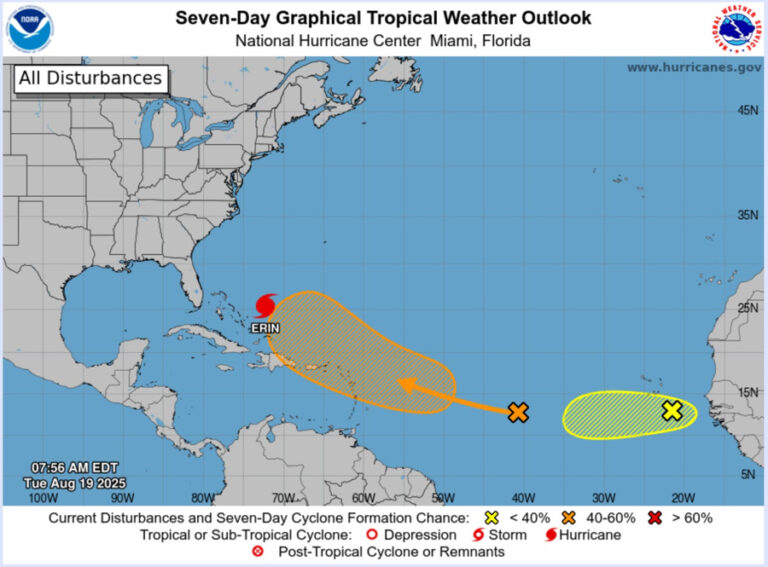
Hurricane Erin grows, threatening storm surge and rain in the Bahamas and North Carolina.
Miami (USA), Aug 19 (EFE) .
Erin, the first hurricane of the Atlantic season, continues to strengthen and increase in size this Tuesday as it moves across the western Atlantic, increasing the risk of dangerous swells, rip currents, and intense rains for the Turks and Caicos Islands, the Bahamas, and the east coast of the United States, especially North Carolina.

The National Hurricane Center (NHC) warned this Monday of an increase in swells and rip currents along much of the east coast of the United States during the next few days, conditions it described as “life-threatening.”
Authorities issued a storm surge watch for the area between Cape Lookout and Duck, North Carolina, where sea levels could rise between 0.6 and 1.2 meters, accompanied by large and dangerous waves.
Additionally, rainfall of 25 to 50 millimeters (1 to 2 inches) is expected on the Outer Banks of North Carolina between Wednesday night and Thursday, with local accumulations of up to 100 millimeters (4 inches) that could cause flash flooding.

The center of the cyclone, a Category 3 out of a total of 5 on the Saffir-Simpson scale, was located this morning about 1,070 kilometers (670 miles) southwest of Bermuda and 1,155 kilometers (700 miles) southeast of Cape Hatteras, North Carolina, with maximum sustained winds of 175 kilometers (109 mph).
The NHC warned that Erin, a large system, has hurricane-force winds extending up to 130 kilometers (80 miles) from its center and tropical-storm-force winds reaching up to 335 kilometers (200 mph).

Erin is moving northwest at 11 kilometers (7 mph), with a turn toward the north expected on Wednesday and toward the northeast on Thursday, when the cyclone is expected to move between the U.S. East Coast and Bermuda.
NHC meteorologists maintain a tropical storm warning for the Turks and Caicos Islands and the southeastern Bahamas, where heavy rain, storm surge, and tropical-storm-strength wind gusts are expected.

A tropical storm watch is also in effect for the central Bahamas, meaning those conditions could develop within the next 48 hours.
The storm emerged as a tropical storm last Monday near Cape Verde in Africa, where it left seven dead, and became a hurricane last Friday after the formation of Cyclones Andrea, Barry, Chantal, and Dexter in the Atlantic.

Chantal was the first hurricane to make landfall in the United States this year, leaving at least two people dead in North Carolina in July.
The National Oceanic and Atmospheric Administration (NOAA) maintained its forecast for an “above-normal” hurricane season, estimating between 13 and 18 tropical storms, of which between five and nine could develop into hurricanes.





